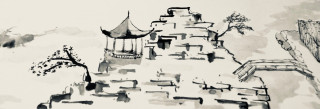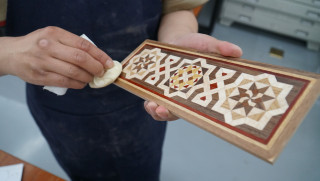COURSES
The Order of Nature: Geometry and Patterns
Click image for video:
This module encourages students to contemplate Geometry’s true inherent meaning in the realm of the order of nature. Students will experience geometry as a contemplative discipline. The skill of concentration, which draws forth the virtue of patience, is required throughout their whole studies. Students deepen their knowledge of design principles by studying patterns and proportions of six-, eight-, twelve- and ten-fold symmetries and their associated proportional systems. Students will learn to analyse and draw these patterns in the context of artistic and architectural elements from East and West. These designs are then applied into a variety of art and craft modules.
Alchemy of Colour: Methods and Materials
Click image for video:
Students learn how to prepare colour pigments, grounds and supports according to traditional methods. They blend paint layers using various techniques to acquire practical knowledge and understanding of colour harmony and symbolism. This module investigates the use of natural pigments—their origin, recipes, meaning and application. Colour exploration is of extreme value to students learning crafts. Each student investigates the subtleties of colour to achieve unity, harmony and contrast, skills later transferred within the art and craft modules. Painting skills are nurtured through practice upon examples of patterns and traditional Chinese landscape painting, with a wider context of applying the principles of colour harmony in themed design projects.
The Language of Nature: Design Motifs
Click image for video:
Theoretical and practical learning of decorative stylisation and design motifs. Students will study and compare nature to its stylisation as manifest in art. This practical study involves rigorous observation of flower and plant forms to create drawings that provide sequential steps to stylisation for a final painting. These stylisations are further arranged into composition to gain the necessary ability and skill to create new designs.
The Constitution of Shanshui: Landscape and Geomancy
Click image for video:
Part 1: In a series of thematic lectures, Prof. Ding Xiyuan analyses the formation of Chinese landscape painting (shanshui), explain the ‘five elements’ theory embedded in shanshui art, and introduce theories of geomancy reflected through shanshui. The lectures include an analysis of historical masterpieces, which allows a deeper insight into the history and thought of the above-mentioned narratives and theories. This is a unique and valuable learning opportunity both for practitioners and lovers of shanshui art.
Part 2: This course focuses on the compositional structure of Chinese landscape painting (shanshui) as the key thread in establishing a foundational understanding of the genre. Specifically, concentration will first be on brushwork formation, and then continue to the study of painting techniques for the two most fundamental elements of Chinese landscape art—rocks and trees—through both copying old master paintings and sketching from nature. The next topic of study is the methodology of placement in the composition, which is the core of shanshui painting, and the means by which the ancients encapsulated the formal codes of the natural world. Within a period of two weeks, students complete two study projects: a study of rocks and trees based on copying, and a landscape composition created by painting in nature.
Design Principles Applied to Wood Products: Marquetry with Veneers
Click image for video:
This course introduces students to the craft of marquetry – wood veneer decoration. Marquetry techniques have been used extensively in Europe, India and the Middle East to decorate wooden items of different scales, from tables to musical instruments to small boxes. This technique achieves intricate designs ranging from geometric patterns to floral motifs. It is sometimes further embellished with inlay of bone, mother of pearl or silver. Today, veneer is still used to add rich and precious elements to beautifully designed contemporary objects.
Students on this short course will learn all the design and craft techniques necessary to translate a pattern - a geometry or a floral motif - into a marquetry panel. Guided by our expert tutor and carpenter Joachim Tantau, all students will learn and work according to proportional systems to achieve coherent and harmonious final pieces. They will explore various woods and veneers and learn how to select and discern between them. Students will learn how to complete their own marquetry pieces from concept design to polishing and finishing.









